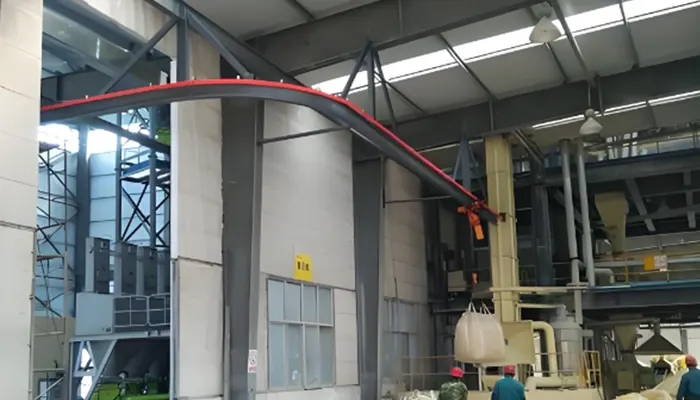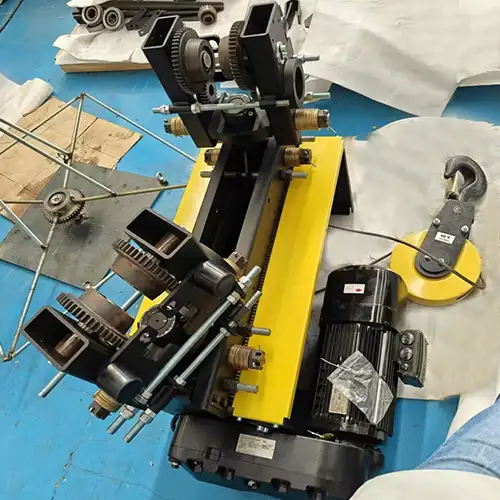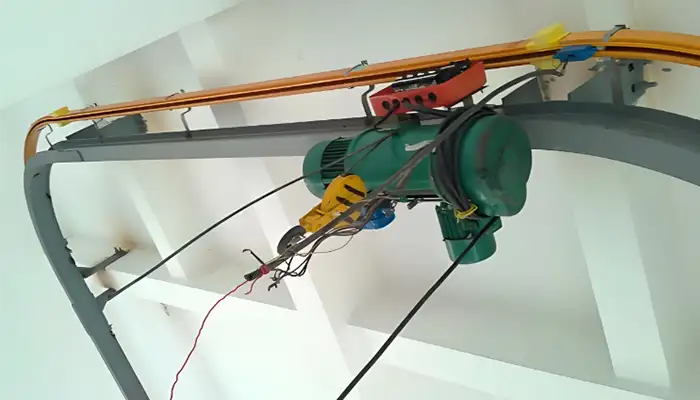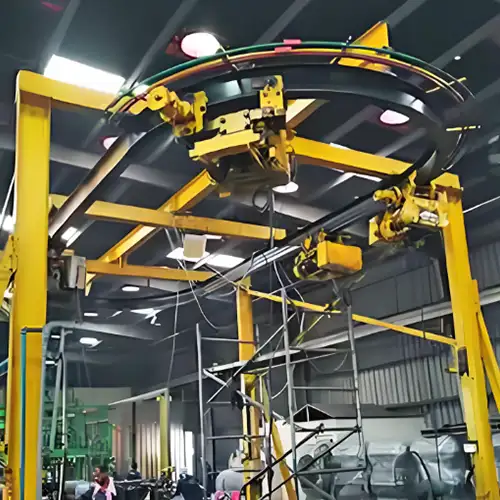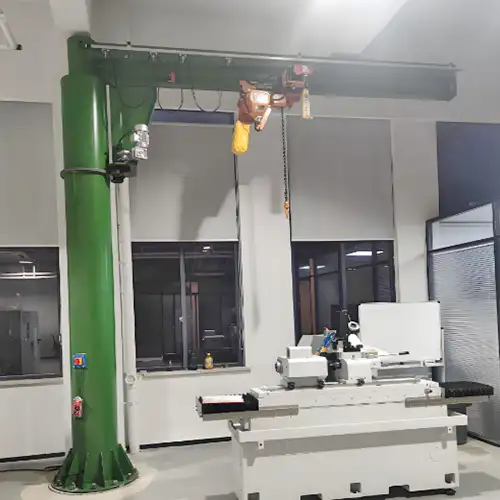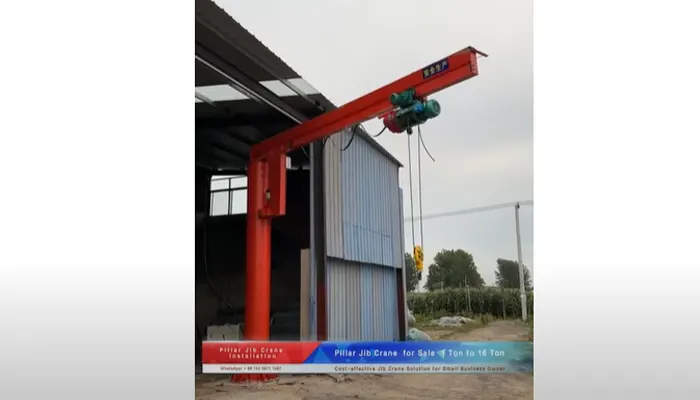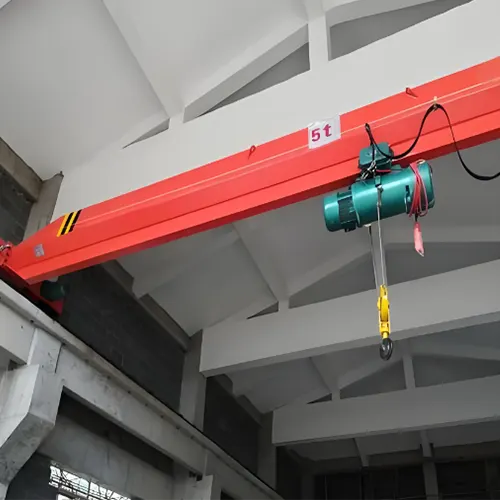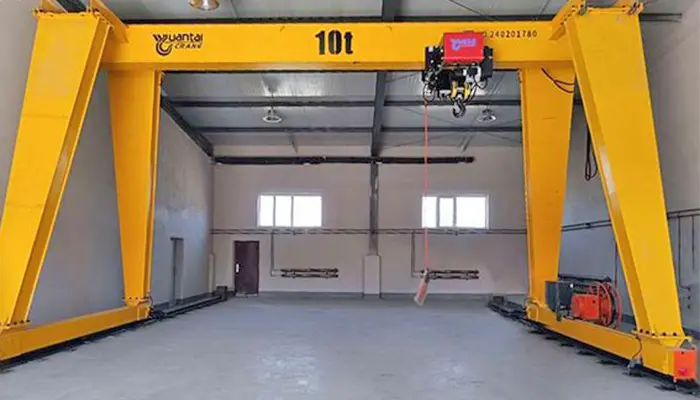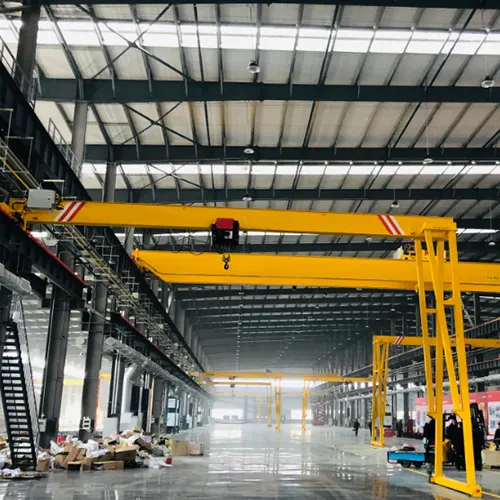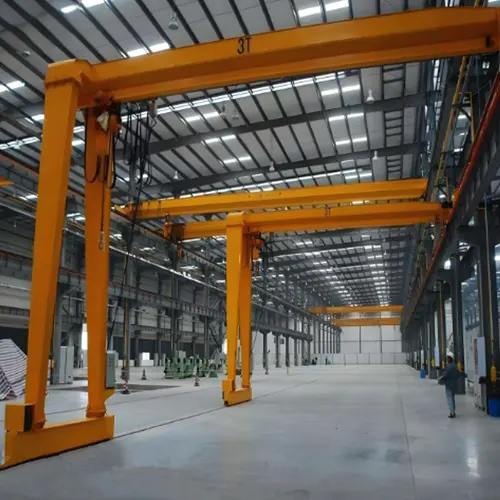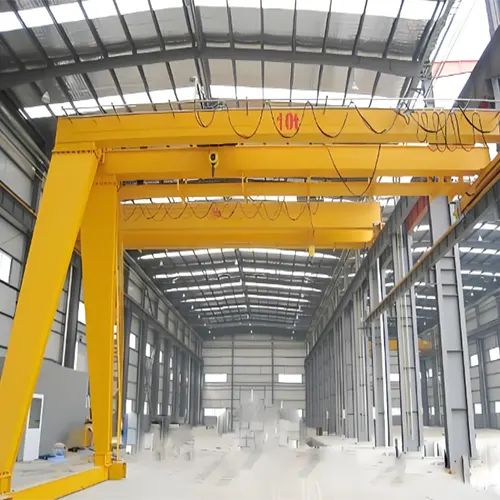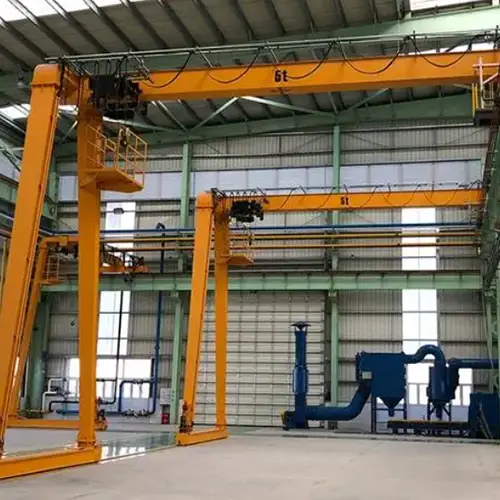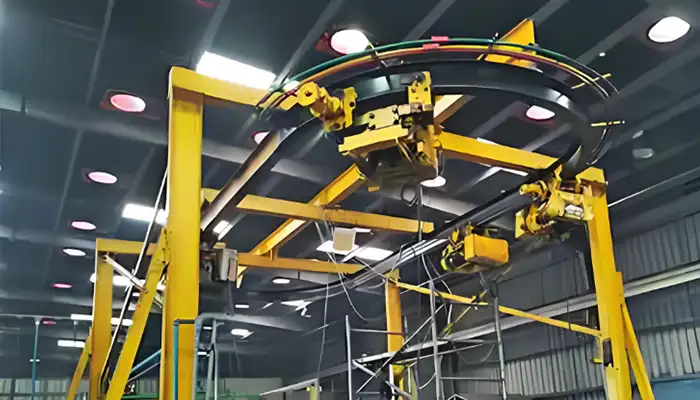
Variable Frequency Drives in Precision Hoisting on Curved Rails
Variable Frequency Drives enhance precision hoisting on curved rails by providing smooth acceleration, deceleration, and improved control over load movements.
Overview of Precision Hoisting
Precision hoisting refers to the controlled and accurate movement of heavy loads, a crucial aspect in industries that demand careful handling of materials. This type of hoisting is especially vital in industries such as manufacturing, automotive assembly, aerospace, and warehousing, where lifting and positioning must be done with exactness. The ability to precisely position loads reduces the risk of damage to both the equipment and the material being handled. Moreover, precision hoisting enhances efficiency and safety, allowing operators to complete tasks more smoothly and with fewer corrections or manual adjustments.
Common applications of precision hoisting systems include tasks that involve fragile, bulky, or awkwardly shaped loads, such as moving large machine parts, assembling complex components, or handling sensitive materials. Industries that rely on automated processes also benefit from precision hoisting, where the ability to fine-tune movements is essential for maintaining workflow consistency and quality control.
Importance of Curved Rails
Curved rails are used in hoisting systems when straight-line movement alone isn't practical. They enable hoists to travel along paths that may curve around obstacles or follow the layout of a facility. This flexibility is especially useful in industries where space constraints or complex floor plans limit straight-line hoisting, such as shipyards, automotive plants, or warehouses with high-density shelving.
The main benefit of curved rails is their ability to increase the versatility of a hoisting system. By following a curved path, hoists can cover more ground within a limited space, reducing the need for multiple lifting devices. They also make it possible to move loads smoothly through areas with irregular layouts or between different sections of a facility without stopping for repositioning.
Typical scenarios where curved rails are utilized include production lines with multiple stages, where a hoist needs to move products or materials through various workstations, or in areas where multiple obstructions, like columns or machinery, require flexible navigation paths. This adds efficiency and improves workflow without requiring extensive system modifications.
Introduction to Variable Frequency Drives (VFDs)
Variable Frequency Drives (VFDs) are devices that control the speed and torque of electric motors by adjusting the frequency and voltage supplied to the motor. In hoisting systems, VFDs are essential for managing the precise movement of the hoist, allowing for smooth starts, stops, and speed changes. They ensure that the motor operates at the exact speed needed for a specific task, which is critical for maintaining control over heavy or sensitive loads.
The significance of VFDs in modern hoisting systems lies in their ability to enhance both performance and safety. VFDs allow for smooth acceleration and deceleration, which minimizes mechanical stress on the hoist and prevents sudden, jerky movements that could endanger the load or the surrounding environment. Additionally, they offer better control over the hoist’s positioning, which is especially important in precision hoisting applications where accuracy is key. By regulating motor speed, VFDs can also help reduce energy consumption, making the system more efficient and cost-effective.
In summary, VFDs provide the necessary control and flexibility that precision hoisting systems, especially those using curved rails, require to function optimally in today’s complex industrial environments.
Variable Frequency Drives
Working Principle of VFDs
Variable Frequency Drives (VFDs) are designed to control the speed and torque of electric motors by adjusting the frequency and voltage of the power supplied. This control is essential for precise hoisting, where smooth, controlled movement is crucial for handling loads without causing damage. The basic principle involves converting incoming AC power to DC and then modulating it back to variable AC through three main stages:
- Rectifier Stage: Converts AC power to DC.
- DC Bus: Stabilizes and stores the converted DC power.
- Inverter Stage: Converts the stabilized DC back into variable-frequency AC, which allows control of motor speed.
The ability to vary the motor's speed through frequency adjustment ensures precise operation, while voltage control helps in managing the torque. This combination allows for smooth acceleration and deceleration, reducing stress on both the hoist and the load.
Key components of a VFD system include:
- Input Rectifier: Responsible for AC to DC conversion.
- DC Bus: Stores and smooths the energy.
- Inverter: Converts DC back into variable AC.
- Control Circuit: Manages speed and torque settings based on input commands.
- Motor: Executes the required operations based on the VFD's output.
This setup ensures precise control, minimizes mechanical wear, and boosts efficiency in hoisting operations.
Types of VFDs
There are two primary types of VFDs used in hoisting systems, each suited to different applications:
Voltage-Source Inverters (VSIs):These are the most commonly used VFDs, operating by converting a constant DC voltage into variable AThey control the motor’s speed by adjusting the frequency and manage torque by varying the voltage. VSIs are known for their straightforward design and cost-effectiveness, making them suitable for a wide range of hoisting tasks where precision and smooth operation are needed.
Applications: Voltage-source inverters are ideal for general-purpose hoisting in industries like manufacturing, automotive assembly, and warehousing, where consistent control of motor speed and torque is important for safe material handling.
Current-Source Inverters (CSIs):CSIs work by controlling the current to manage motor speed, making them more suitable for heavy-duty applications. Unlike VSIs, which adjust voltage, CSIs maintain a constant current to regulate speed. This provides high torque at low speeds, which is critical for lifting heavier loads with precise control.
Applications: Current-source inverters are commonly used in environments such as steel mills and shipyards, where hoisting large, heavy loads requires high starting torque and careful control throughout the lift.
In both types, VFDs offer the ability to fine-tune motor performance, providing the flexibility needed for a variety of hoisting applications, from light precision tasks to heavy industrial lifting.
Benefits of VFDs in Precision Hoisting
Enhanced Control and Accuracy
Variable Frequency Drives (VFDs) significantly improve the precision of lifting operations by allowing operators to control both the speed and torque of hoisting motors with exceptional accuracy. Unlike traditional hoisting systems, which may operate at fixed speeds or require manual adjustments, VFDs enable smooth and gradual changes in motor performance. This precision is critical in applications that demand exact load positioning, such as in assembly lines, aerospace, and warehousing, where even slight misalignment can lead to costly errors or equipment damage.
The ability to fine-tune speed and movement allows operators to place loads with pinpoint accuracy, making VFDs indispensable for tasks that involve sensitive or fragile materials. For instance, in industries handling high-value components or materials that require precise placement—such as automotive manufacturing or electronics—accurate hoisting systems minimize risks and ensure efficient workflows. VFDs also enhance safety, reducing the likelihood of accidental drops or collisions that can occur due to abrupt or uncontrolled movements.
Smooth Acceleration and Deceleration
One of the most noticeable benefits of VFDs in hoisting systems is their ability to provide smooth acceleration and deceleration. This gradual transition prevents the sudden jerks or stops that can cause instability in loads, which is particularly important when moving heavy or bulky materials. By enabling a controlled start and stop, VFDs ensure that the load remains stable during movement, reducing the risk of swinging or shifting, which can endanger both the load and the surrounding environment.
Compared to traditional motor controls, which may start and stop the motor abruptly, VFDs offer a more refined approach to load handling. In systems without VFDs, the motor is often subject to rapid changes in speed, which can place considerable strain on mechanical components, increasing the chances of wear and tear. The smooth transitions provided by VFDs not only improve the safety of the hoisting process but also prolong the lifespan of the hoisting equipment by reducing mechanical stress.
Energy Efficiency
VFDs contribute to substantial energy savings by adjusting motor speed to match the specific needs of the task at hand. Traditional motors often run at a constant speed regardless of load requirements, leading to unnecessary energy consumption, particularly when lower speeds would suffice. VFDs, however, allow motors to operate more efficiently by reducing speed during lighter loads or idle times, cutting down on excess energy use.
This level of energy efficiency translates into long-term cost savings for businesses. By reducing energy consumption, VFDs lower operational expenses and help businesses meet energy efficiency goals, which is becoming increasingly important in today’s industrial landscape. Additionally, the energy savings achieved with VFDs contribute to a reduced environmental footprint, making them a more sustainable option for modern industries.
Reduced Mechanical Stress
Another significant advantage of VFDs is their ability to minimize mechanical stress on hoisting equipment. By allowing for controlled, gradual speed changes, VFDs reduce the strain placed on gears, motors, and other components during operation. Traditional hoisting systems, which may experience abrupt starts and stops, can lead to premature wear and tear, increasing maintenance needs and the risk of equipment failure.
VFDs, by contrast, protect mechanical components by ensuring smoother operation, which reduces the frequency of maintenance and repairs. This not only extends the lifespan of the equipment but also reduces downtime, leading to improved productivity. The long-term reduction in mechanical stress also lowers operational costs, as businesses spend less on replacement parts and emergency repairs.
In summary, the benefits of VFDs in precision hoisting go beyond immediate operational improvements. They enhance control and accuracy, provide smoother load handling, reduce energy consumption, and minimize mechanical stress, all of which contribute to safer, more efficient, and cost-effective hoisting systems.
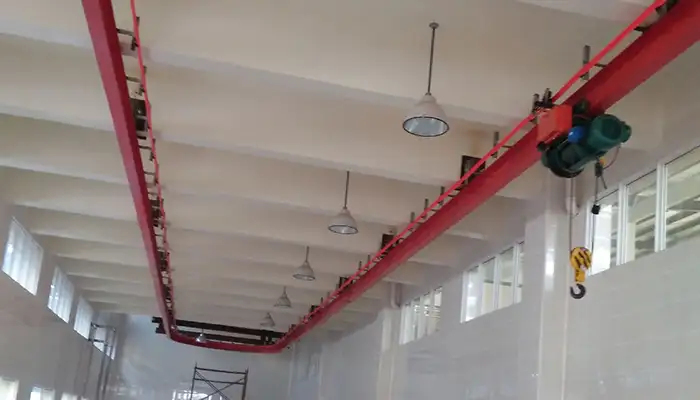
The Application of VFDs on Curved Rails
Challenges of Hoisting on Curved Rails
Hoisting on curved rails introduces unique challenges compared to straight rails, primarily due to the changes in dynamics and load behavior. As the hoisting system moves along the curve, the load’s center of gravity shifts, creating additional forces that can destabilize the load or cause unwanted sway. This is particularly problematic with heavy or sensitive materials that must be handled carefully. Additionally, curved rail systems often experience increased friction and strain on the hoisting mechanism, making it harder to maintain control, especially at higher speeds.
Stability is another critical concern, as loads on curved rails are more prone to lateral movement. In traditional hoisting systems, maintaining precise control of the load while navigating these curves is difficult. The inability to adjust motor speed and torque in response to these changing dynamics can lead to accidents, damage to the load, or even system failure.
Role of VFDs in Overcoming Challenges
Variable Frequency Drives (VFDs) play a vital role in addressing the challenges of hoisting on curved rails by allowing operators to tailor the motor's speed and torque to the unique demands of curved track sections. VFDs can dynamically adjust the motor’s output, slowing down or speeding up as needed to match the curvature of the rail, ensuring smoother transitions and preventing sudden shifts in the load's position. This control is critical in maintaining stability and reducing the risk of unwanted sway or movement that could result from navigating curves at high speeds.
Moreover, VFDs enhance the responsiveness of the system to dynamic loads, which can change as the hoist moves along a curve. By continuously monitoring and adjusting motor performance, VFDs ensure that the hoist adapts to the varying forces exerted on the load, maintaining safe and controlled movement. The ability to fine-tune motor behavior based on the curvature of the rail and the characteristics of the load significantly improves overall system performance and safety.
Case Studies and Real-World Applications
Several industries have successfully implemented VFDs on curved rail systems, leading to notable improvements in precision and efficiency. One prominent example is in the automotive manufacturing sector, where overhead cranes fitted with VFDs are used to move car bodies and other large components along curved tracks. By leveraging VFD technology, these systems can adjust speed and torque based on the rail’s curvature, ensuring smooth handling of materials throughout the assembly process. This has reduced downtime caused by misaligned loads and improved the safety of operations.
In another case, a warehousing company integrated VFDs into their hoisting system for curved rail applications to move goods between different sections of their facility. The use of VFDs allowed for better control of speed when transitioning through curved sections, reducing the risk of damage to sensitive goods during transportation. This optimization led to a measurable increase in efficiency and a reduction in operational costs due to fewer maintenance requirements and less damage to inventory.
These real-world examples demonstrate the tangible benefits of utilizing VFDs in curved rail hoisting applications, from enhanced control and load stability to improved overall performance and cost savings. The ability of VFDs to overcome the challenges associated with curved rails makes them an essential component in modern hoisting systems across a wide range of industries.
Technical Considerations for Implementing VFDs
Selection of Appropriate VFDs
Choosing the right Variable Frequency Drive (VFD) for precision hoisting applications requires careful consideration of several factors. The most critical element is the load capacity and the specific demands of the hoisting system. The VFD must be capable of handling the motor’s power requirements and provide sufficient torque control to ensure smooth operation, especially in scenarios involving curved rails or complex load movements.
Another key factor is speed range. The VFD should allow for a broad range of speeds to accommodate the varying requirements of different lifting tasks, from slow, precise positioning to faster, bulk material handling. Additionally, VFDs should offer customizable settings for acceleration and deceleration, ensuring the hoist operates smoothly under various conditions.
Compatibility with existing systems is another essential consideration. Not all VFDs are universally compatible with every hoisting system. Before selecting a VFD, it’s important to verify that it integrates seamlessly with the hoist’s motor and control system. For instance, the VFD should be compatible with the motor’s voltage and current ratings, as well as any safety features like emergency stops or overload protection mechanisms. This ensures that the VFD enhances the system’s performance without requiring major modifications or upgrades.
Integration with Hoisting Systems
The successful integration of a VFD into a hoisting system involves a precise installation process that must follow industry best practices to ensure optimal performance. First and foremost, the electrical infrastructure should be evaluated to ensure it can support the VFD’s power requirements. This includes checking the supply voltage, circuit breakers, and grounding systems to avoid electrical issues that could compromise the VFD’s performance.
The mounting location of the VFD is another critical consideration. It should be placed in an area that minimizes exposure to environmental factors such as dust, moisture, or excessive heat, which can shorten the lifespan of the drive. Proper ventilation and cooling mechanisms are essential to prevent the VFD from overheating during heavy use.
Given the complexity of installing VFDs, it is highly recommended to employ skilled technicians with expertise in hoisting systems and VFD technology. Professional installation ensures that the VFD is configured correctly, including setting the correct parameters for speed, torque, and braking. Technicians should also perform initial tests to verify that the VFD integrates smoothly with the motor and controls, ensuring that the hoist operates efficiently and safely right from the start.
Monitoring and Maintenance of VFD Systems
Routine monitoring and maintenance are essential for ensuring the long-term reliability and efficiency of VFD systems in precision hoisting. Regular checks should be conducted to assess the performance of the VFD, looking for any signs of wear or malfunction in the electrical components. Monitoring the temperature, voltage fluctuations, and motor feedback will help identify potential issues early, preventing costly breakdowns or unexpected downtime.
Additionally, VFD systems require periodic software updates and calibration to maintain their precision and efficiency. Modern VFDs often come with advanced software that allows operators to adjust parameters, monitor performance, and even run diagnostics remotely. Keeping this software up to date ensures that the VFD operates with the latest features and safety protocols, which can further enhance its energy efficiency and operational reliability.
If problems arise, troubleshooting should be performed by experienced personnel familiar with the specific VFD model and its integration within the hoisting system. Some common issues include voltage spikes, improper parameter settings, and motor misalignment, all of which can be diagnosed and corrected by a skilled technician.
In conclusion, selecting, integrating, and maintaining VFDs requires careful planning and expertise, but the benefits in terms of precision, efficiency, and longevity far outweigh the challenges. By following these technical considerations, businesses can ensure that their VFD systems provide reliable, high-performance hoisting for years to come.
Future Trends in Precision Hoisting with VFDs
Technological Advancements
As technology continues to evolve, Variable Frequency Drives (VFDs) are becoming more advanced and adaptable, especially in precision hoisting applications. One of the key innovations is the development of smart VFD systems, which integrate advanced sensors and real-time data analytics. These systems can automatically adjust motor performance based on environmental factors, load characteristics, and rail dynamics, improving both safety and efficiency in challenging scenarios like curved rail hoisting.
Another emerging trend is artificial intelligence (AI) and machine learning (ML) integration within VFDs. With AI algorithms, VFDs can learn from past operations and make predictive adjustments, optimizing performance over time. For instance, AI-enhanced VFDs can detect patterns in load behavior and preemptively adjust torque and speed settings to prevent issues like swaying or imbalances, leading to even greater precision in hoisting.
Additionally, the rise of Internet of Things (IoT)-connected VFD systems allows for remote monitoring and control. These systems enable operators to access detailed performance data, run diagnostics, and even make adjustments from offsite locations, enhancing operational flexibility. This connectivity also supports predictive maintenance, where potential issues are flagged early, reducing downtime and improving the longevity of the hoisting system.
Industry Adoption and Market Growth
As the benefits of VFDs in precision hoisting become more widely recognized, industry adoption is increasing across multiple sectors. In industries such as manufacturing, construction, and logistics, the demand for precise, reliable hoisting solutions has led to significant investments in VFD technologies. This trend is particularly strong in sectors dealing with delicate or high-value materials, such as automotive manufacturing, aerospace, and pharmaceuticals, where precise control over lifting and positioning is critical.
The crane and hoisting industry itself is also seeing significant growth due to the adoption of VFDs. The ability of VFDs to improve efficiency, reduce energy consumption, and minimize mechanical wear aligns with industry-wide goals of sustainability and cost reduction. As industries increasingly prioritize automation and intelligent systems, the adoption of VFD-controlled hoists is expected to grow rapidly.
Market forecasts indicate that the global VFD market for hoisting systems will continue to expand, driven by both technological advancements and the growing need for energy-efficient solutions. Governments and industries alike are setting targets for reducing carbon footprints, and VFDs play a crucial role in this by optimizing motor efficiency and reducing overall power consumption. As a result, VFD technology is likely to become a standard in hoisting systems, with continued innovation pushing the boundaries of what’s possible in precision lifting.
In summary, the future of precision hoisting with VFDs looks promising, with ongoing advancements in technology and increased adoption across industries fueling both performance improvements and market growth.
Conclusion
Throughout this guide, we have explored the crucial role of Variable Frequency Drives (VFDs) in precision hoisting, particularly on curved rails. From their fundamental working principles and various types to the significant benefits they bring, VFDs have emerged as an indispensable technology in modern hoisting systems. We discussed how VFDs enhance control and accuracy, enable smoother acceleration and deceleration, improve energy efficiency, and reduce mechanical stress, all of which contribute to safer and more efficient operations. Additionally, we examined the challenges of hoisting on curved rails and how VFDs address these issues, ensuring stability and precision in complex rail systems.
VFDs offer a transformative solution for precision hoisting, especially when navigating curved rails. The ability to dynamically adjust speed and torque based on real-time conditions makes them invaluable in maintaining control and stability, even in the most challenging scenarios. For industries that rely on precise lifting and transportation of materials—such as automotive, aerospace, manufacturing, and warehousing—VFDs provide unparalleled performance improvements. They reduce wear on equipment, minimize energy consumption, and ensure the safety of both materials and operators. As more industries embrace curved rail systems to optimize their workflows, VFDs will continue to play a pivotal role in elevating hoisting capabilities.
The future of precision hoisting lies in adopting advanced technologies like VFDs. For industries looking to improve operational efficiency, reduce costs, and enhance the precision of their hoisting systems, VFDs offer a proven solution. Now is the time to invest in VFD technology, ensuring that your hoisting systems are not only equipped to handle current demands but are also future-ready for continued growth and innovation. By integrating VFDs into your operations, you can unlock new levels of performance, safety, and sustainability in your hoisting processes.
